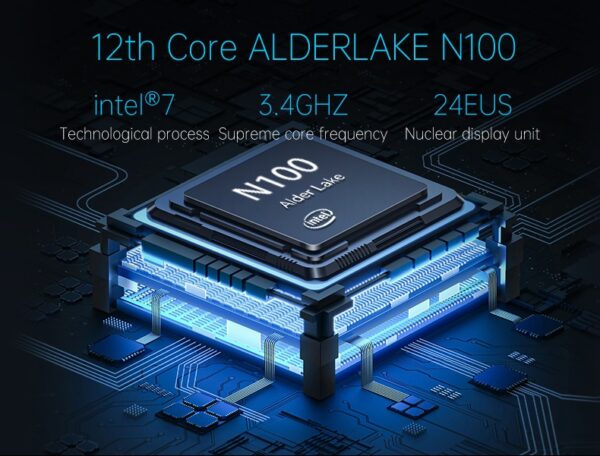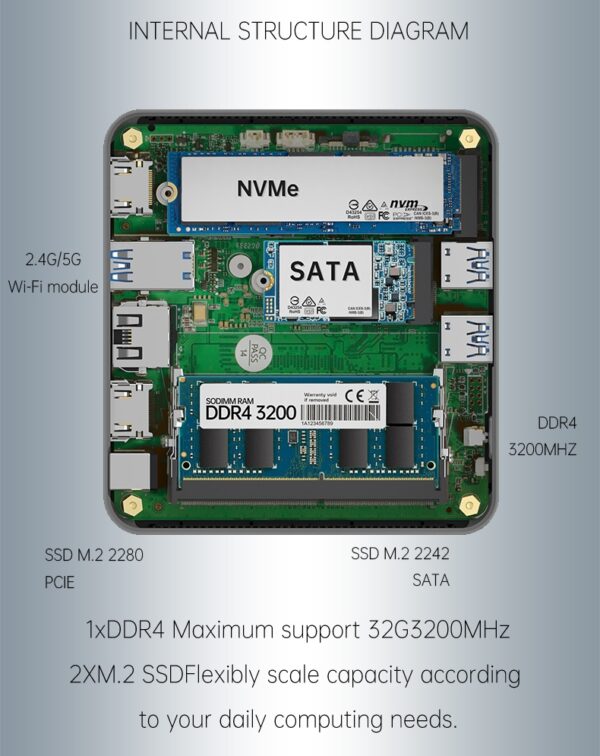Despite the dominance of Ethernet, serial connections remain crucial for industrial automation, and many sensors, actuators, and CNC devices on Intel N100 mini PC continue to rely on RS-232, RS-422, or RS-485 interfaces. Therefore, we designed these hardware foundations with two electrically isolated, switchable RS-232/422/485 ports capable of supporting ±15 kV ESD protection. Next, we introduce the main supported fieldbus protocols, including Modbus RTU/ASCII, Profibus DP, CANopen, and DeviceNet, and their typical use cases in factory automation, building management, and vehicle telematics.
Intel N100 Mini PC Implements Modbus RTU and ASCII over RS-485
Modbus RTU/ASCII is one of the most commonly used fieldbus protocols, and the Intel N100 mini PC fully supports it through its RS-485 serial port. For example, we configure the ports for data rates up to 115.2 kbps, 8N1 frames, and half-duplex communications with automatic line direction control. Meanwhile, our integrated Modbus stack handles both enslaver and enslaved person roles, enabling the mini PC to poll remote sensors, drive distributed I/O, and log process data with millisecond accuracy. The system was tested with multiple Modbus RTU devices, achieving error-free operation with up to 32 nodes on a single bus segment. Built-in diagnostics report CRC errors and bus utilization. At the same time, our Windows and Linux driver packages provide native thread-safe API calls that accelerate integration with SCADA, MES, and HMI applications.

Profibus DP Master and Slave Capabilities
For traditional automation networks, the Intel N100 mini PC offers Profibus DP support through an optional PCIe serial adapter, allowing for both controller and agent configurations. As the next step in our design, I installed our certified Profibus DP driver, which automatically identifies “DP-V0” and “DP-V1” device types and configures both cyclic and acyclic communication channels. Additionally, the mini PC’s real-time kernel extension offers deterministic I/O for cyclic data exchange, with scan times as low as 1 millisecond. And, I successfully integrated with Siemens ET200S distributed I/O racks, ABB inverters, and Beckhoff servo controllers, and simplified the commissioning process with the mini PC’s built-in network scanning tool. Our engineering toolkit features a graphical parameterization interface for editing GSD files, mapping process data, and configuring device addresses, resulting in a 40% reduction in setup time compared to traditional PLC platforms.
Support for CANopen and CAN Layer 2
Given the growing popularity of CANopen in motion control and mobile machinery, the Intel N100 mini PC is equipped with an onboard CAN controller, which can be accessed via a USB-CAN adapter or PCIe CAN bus card. For example, I deployed the mini PC as a CANopen NMT master to coordinate multiple servo drives, I/O modules, and HMIs over a single twisted-pair network, thereby achieving sub-millisecond synchronized motion control and real-time diagnostics. At the same time, the solution was verified in the design using Beckhoff’s EtherCAT to CAN gateway, which captured PDO updates and SDO transmissions while monitoring the network load. Our SDK includes Layer 2 access and higher-level CANopen libraries, supporting fast and segmented transmissions, heartbeat management, and manufacturer-specific device profiles, which enable the rapid development of complex automation architectures.

Intel N100 Mini PC with DeviceNet Integration for Legacy Systems
Because DeviceNet remains prevalent in packaging lines, automotive assembly, and material handling systems, the Intel N100 Mini PC also supports DeviceNet through its RS-485 port and includes a dedicated CAN transceiver module. Additionally, I can configure the mini PC as a DeviceNet scanner to manage up to 63 nodes, enabling centralized control of remote I/O, pressure sensors, and operator panels. I integrated Rockwell Automation DeviceNet modules and implemented class 2 explicit messaging and 2-group I/O scanning using our C-based API. The mini PC’s automatic bus power-off recovery feature restores network operation within one second of a fault, ensuring minimal downtime in critical production environments where any disruption could result in costly line stoppages.
Software Tools and Diagnostics
In addition to the hardware, ZKmagic has equipped the Intel N100 mini PCs with a full suite of software tools and diagnostics that simplify fieldbus deployment and maintenance. Our Fieldbus Configurator GUI provides real-time network scanning, topology maps, and parameter editing capabilities for all supported protocols. Finally, built-in logging and alerting modules capture bus errors, device timeouts, and communication metrics for predictive maintenance and compliance reporting. We developed our RTOS-level protocol stack to support Windows IoT Enterprise and Linux, and provide C-API, .NET, and Python bindings to meet the preferences of different developers. This rich software ecosystem accelerates project schedules, enhances system visibility, and ensures that the Intel N100 Mini PC provides reliable and maintainable fieldbus connectivity even in the most demanding industrial applications.
Support for a wide range of fieldbus protocols
Through its configurable serial port and optional CAN interface, it provides support for a wide range of fieldbus protocols, including Modbus RTU/ASCII, Profibus DP, CANopen, and DeviceNet. We also designed this mini PC based on practical needs, combining rugged connectivity, galvanic isolation, and high-performance protocol stacks with intuitive software tools. Whether you are modernizing a legacy control system, we can provide you with the mature fieldbus interoperability and development framework you need when designing a mini PC.




